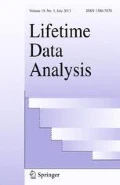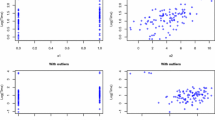Abstract
The linear transformation model is a semiparametric model which contains the Cox proportional hazards model and the proportional odds model as special cases. Cai et al. (Biometrika 87:867–878, 2000) have proposed an inference procedure for the linear transformation model with correlated censored observations. In this article, we develop formal and graphical model checking techniques for the linear transformation models based on cumulative sums of martingale-type residuals. The proposed method is illustrated with a clinical trial data.
Similar content being viewed by others
References
Barlow WE and Prentice RL (1988). Residuals for relative risk regression. Biometrika 75: 65–74
Bilias Y, Gu M and Ying Z (1997). Toward a general asymptotic theory for Cox model with staggered entry. Ann Statist 25: 662–682
Cai T, Wei LJ and Wilcox M (2000). Semiparametric regression analysis for clustered failure time data. Biometrika 87: 867–878
Cheng SC, Wei LJ and Ying Z (1995). Analysis of transformation models with censored data. Biometrika 82: 835–845
Cheng SC, Wei LJ and Ying Z (1997). Predicting survival probabilities with semiparametric transformation models. J Am Statist Assoc 92: 227–235
Cox DR (1972). Regression models and life tables (with discussion). J Roy Stat Soc B 34: 187–220
Fleming TR, Harrington DP (1991) Counting processes and survival analysis. Wiley
Hida T (1975) Brownian motion. Iwanami Shoten (in Japanese)
Lee EW, Wei LJ, Amato DA (1992) Cox-type regression analysis for large numbers of small groups of correlated failure time observations. In: Klein JP, Goel PK (eds) Survival analysis: state of the art. Kluwer Academic, Dordrecht, pp 237–247
Lee EW, Wei LJ and Ying Z (1993). Linear regression analysis for highly stratified failure time data. J Amer Statist Assoc 88: 557–565
Lin DY, Wei LJ and Ying Z (1993). Checking the cox model with cumulative sums of martingale-based residuals. Biometrika 80: 557–572
Lin DY and Wei LJ (1991). Goodness-of-fit tests for the general Cox regression model. Statistica Sinica 1: 1–17
Lin DY and Ying Z (1994). Semiparametric analysis of the additive hazard risk model. Biometrika 81: 61–71
Pollard D (1990). Empirical processes: theory and applications. Institute of Mathematical Statistics, Hayward
Spiekerman CF and Lin DY (1996). Checking the marginal cox model for correlated failure time data. Biometrika 83: 143–156
Spiekerman CF and Lin DY (1998). Marginal regression models for multivariate failure time data. J Am Statist Assoc 93: 1164–1175
Therneau TM (2000) Modeling survival data. Springer
Therneau TM and Grambsch PM (1990). Martingale-based residuals for survival models. Biometrika 77: 147–160
Wei LJ, Ying Z and Lin DY (1990). Linear regression analysis of censored survival data based on rank tests. Biometrika 77: 845–851
Ying Z (1993). A large sample study of rank estimation for censored regression data. Ann Statist 21: 76–99
Ying Z and Wei LJ (1994). The Kaplan–Meier estimate for dependent failure time observations. J Mult Anal 50: 17–29
Author information
Authors and Affiliations
Corresponding author
Rights and permissions
About this article
Cite this article
Hattori, S. Checking the linear transformation model for clustered failure time observations. Lifetime Data Anal 14, 253–266 (2008). https://doi.org/10.1007/s10985-008-9082-4
Received:
Accepted:
Published:
Issue Date:
DOI: https://doi.org/10.1007/s10985-008-9082-4




